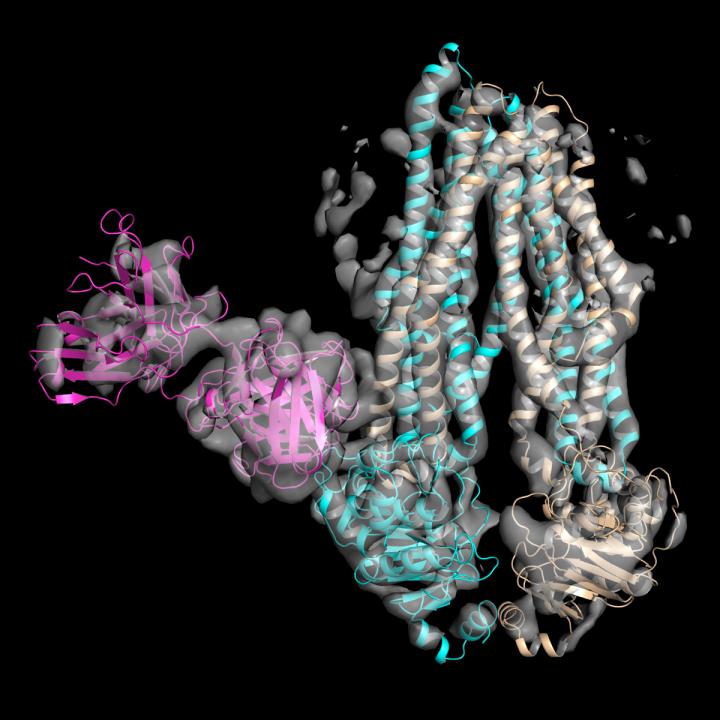How cells defend themselves against antibiotics and cytostatic agents

With the aid of a high-resolution cryo-electron microscope, the group led by Robert Tampé, in collaboration with colleagues at the University of California in San Francisco, succeeded in determining the structure of an asymmetrical ABC transporter complex. Credit: Robert Tampé
“On the one hand, ABC transporters causes diseases such as cystic fibrosis, while on the other hand they are responsible for the immune system recognising infected cells or cancer cells,” explains Professor Robert Tampé from the Institute for Biochemistry at the Goethe University.
The considerable medical, industrial and economic significance of ABC transporters is also based on the fact that they cause bacteria and other pathogens to become resistant to antibiotics. Likewise, they can help cancer cells to defend themselves against cytostatic agents and thus determine whether chemotherapy will succeed.
For the first time, the group led by Robert Tampé, in collaboration with colleagues at the University of California in San Francisco, succeeded in determining the structure of an asymmetrical ABC transporter complex with the aid of a high-resolution cryo-electron microscope.
“Over a period of five years, we have successfully implemented a number of innovative, methodological developments. These have enabled us to gain insights that previously were unimaginable,” says Tampé.
The researchers report in the current issue of the renowned scientific journal, Nature that they have succeeded in investigating a single frozen ABC transport complex at a subnanometer resolution that has never before been achieved.
For this purpose, they used a newly developed single electron camera, new imaging processes and specific antibody fragments in order to determine the structure and conformation of the dynamic transport machine.
“The combination of physical, biotechnological, biochemical and structural biological methods has led to a quantum leap in the elucidation of the structure of macromolecular complexes,” says Tampé. The method facilitates the targeted development of a trend-setting therapeutic approach.
Media Contact
All latest news from the category: Life Sciences and Chemistry
Articles and reports from the Life Sciences and chemistry area deal with applied and basic research into modern biology, chemistry and human medicine.
Valuable information can be found on a range of life sciences fields including bacteriology, biochemistry, bionics, bioinformatics, biophysics, biotechnology, genetics, geobotany, human biology, marine biology, microbiology, molecular biology, cellular biology, zoology, bioinorganic chemistry, microchemistry and environmental chemistry.
Newest articles

A universal framework for spatial biology
SpatialData is a freely accessible tool to unify and integrate data from different omics technologies accounting for spatial information, which can provide holistic insights into health and disease. Biological processes…

How complex biological processes arise
A $20 million grant from the U.S. National Science Foundation (NSF) will support the establishment and operation of the National Synthesis Center for Emergence in the Molecular and Cellular Sciences (NCEMS) at…

Airborne single-photon lidar system achieves high-resolution 3D imaging
Compact, low-power system opens doors for photon-efficient drone and satellite-based environmental monitoring and mapping. Researchers have developed a compact and lightweight single-photon airborne lidar system that can acquire high-resolution 3D…





















